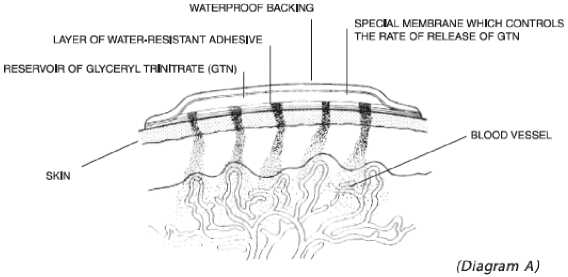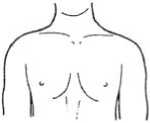Transiderm-Nitro 5 Patches
PACKAGE LEAFLET: INFORMATION FOR THE USER TRANSIDERM-NITRO® 5 PATCHES (glyceryl trinitrate)
What you need to know about Transiderm-Nitro® 5
Your doctor has decided that you need this medicine to help treat your condition.
Please read this leaflet carefully before you start to use the patches. It contains important information. Keep the leaflet in a safe place because you may want to read it again.
If you have any other questions, or if there is something you don't understand, please ask your doctor or pharmacist.
This medicine has been prescribed for you. Never give it to someone else. It may not be the right medicine for them even if their symptoms seem to be the same as yours.
If any of the side effects gets serious, or if you notice any side effects not listed in this leaflet, please tell your doctor or pharmacist.
This product will be referred to as Transiderm-Nitro in this leaflet.
In this leaflet:
1. What Transiderm-Nitro patches are and what they are used for
2. Things to consider before you start to use Transiderm-Nitro patches
3. How to use Transiderm-Nitro
4. Possible side effects
5. How to store Transiderm-Nitro
6. Further information
1. What Transiderm-Nitro patches are and what they are used for
Transiderm-Nitro is a patch which you stick on your skin. The patch contains a supply of glyceryl trinitrate which is released from the patch and absorbed through the skin and into the blood vessels.
This is called a transdermal patch. See diagram of patch below.

Glyceryl trinitrate, the active ingredient in the patches is one of a group of medicines called vasodilators. These cause blood vessels to relax, increasing the supply of blood and oxygen to the heart and reducing the amount of work the heart has to do.
Transiderm-Nitro is used
• to prevent angina attacks. Angina means a painful tightness in the chest. This is a good description of a typical attack, although the pain may also be felt in the arm or neck. The pain really comes from the heart muscle and is a sign that part of the muscle is not getting enough blood supply for the amount of work it has to do.
Transiderm-Nitro is also used in patients who are receiving food or drugs directly into a vein (intravenously)
• to prevent irritation and the intravenous fluid leaking into the surrounding tissues.
2. Things to consider before you start to use Transiderm-Nitro patches
Some people MUST NOT use Transiderm-Nitro patches.
Talk to your doctor if:
• you think you may be allergic to glyceryl trinitrate or other nitrates or to any of the other ingredients of the patch. (These are listed at the end of the leaflet.)
• you have very low blood pressure.
• you have headaches, vomiting or seizures as a result of raised pressure inside the skull.
• you have any problems with your heart because of faulty valves or inflammation.
• you are taking any medicines for erectile dysfunction (male impotence).
If you are hospitalised due to severe dehydration or loss of blood tell the doctor you are using a Transiderm-Nitro patch.
You should also ask yourself these questions before using the patch:
• Have you recently had a heart attack or do you have heart failure or other heart problems?
• Do you suffer from anaemia or lung disease?
• Are you pregnant or trying to become pregnant?
• Are you breast feeding?
If the answer to any of these questions is YES, tell your doctor or pharmacist because Transiderm-Nitro might not be the right medicine for you.
Are you taking other medicines?
Transiderm-Nitro interacts with a large number of other medicines.
Tell your doctor or pharmacist if you are taking any of the following:
• Medicines for depression
• Ergotamine products which are usually given for migraine
• Medicines for erectile dysfunction (male impotence)
• Medicines for high blood pressure or heart problems
• Aspirin or other painkillers called NSAIDs (non-steroidal antiinflammatory drugs)
• Diuretics ("water tablets")
• Tranquillisers (e.g. chlorpromazine, flupenthixol, haloperidol, clozapine).
Always tell the doctor or pharmacist about all of the medicines you are taking. This means medicines you have bought yourself, as well as medicines on prescription from the doctor.
Will there be any problems with driving or using machinery?
Some people have reported feeling faint or dizzy when they have started to use the patches. You should not drive or operate machinery if you are affected.
Other special warnings
Be careful when drinking alcohol as the patch may affect you more than usual and you might feel faint or dizzy.
You must tell the doctor or nurse if you are wearing a patch before an MRI scan (Magnetic Resonance Imaging scan to visualise internal organs and tissues of the body) or diathermy treatment (treatment using hot wires) and before electrical treatment on the heart.
How to use Transiderm-Nitro patches
It is important to follow what your doctor says about how and when to use your patches. The dose will be on the pharmacist's label. Check the label carefully. If you are not sure, ask your doctor or pharmacist.
The doctor will tell you how often to change the patch. Discard the old patch carefully because it will still contain a little of the active ingredient.
The side of the chest is a suitable place to apply the patch. Choose a different area of skin each time you apply a new patch. Leave several days before you use the same patch of skin again.
How to apply the patch
Decide where you will put the patch. It is important that you put it on a hairless area to ensure that it sticks well.
The side of the chest is recommended.
Wash the skin and dry it thoroughly to make sure the patch sticks well. Wait a minute until the skin feels quite dry.
Do not use powder.
I
I
I
You might find that your GTN (glyceryl trinitrate) tablets or spray aren't — working as well as they used to. Discuss this with your doctor.
I
I
3.

1

2